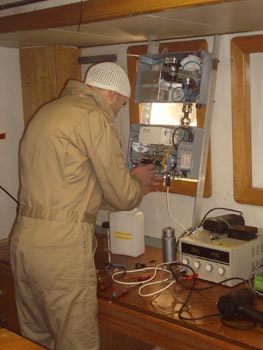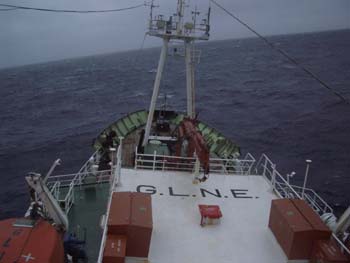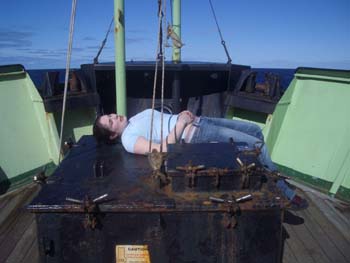


 |
 |
 |
D317 Cruise Diary
D317 is the second cruise for the SEASAW project, following our joint cruise (D313) with the DOGEE project team in November/December 2006. We sailed from Glasgow on at 11am on March 21 after a couple of days installing instrumentation in port.
These pages will be added to intermittently during the cruise. Near real time meteorological measurements and ship position can also be found on the AUTOFLUX website run by our collaborators at the National Oceanographic Centre in Southampton.
 |
Thursday, March 22, 2007
We are currently heading for 60N 15W, expecting to arrive 2pm tomorrow, ready to catch the southern edge of a low pressure system and winds of force 7 or 8.
 |
 |
|
| The RRS Discovery in the King George V Dock, Govan | Ian and Anthony in the main lab | |
 |
 |
|
| Ian and Anthony suspended 20m up while installing the turbulence instrumentation on the top of the foremast. | Jim installing the refill line to enable topping up of the chromotropic acid reservoir in the FLOS ozone instrument on the foremast. |
 |
The Leeds team consist of of Ian Brooks (PI), Sarah Norris, Justin Lingard, PhD student Paul Smith, and MRes Student Anthony Bloom. For the mobilization period we were joined by Mike Smith, Barbara Brooks, and Jim McQuaid. With no other science teams involved in this cruise it seems very quiet on board. Mobilization went very smoothly second time round, having figured out most of the problems during D313. We have one new instrument on this cruise: Jim McQuaid and Paul Smith's Fast Lightweight Ozone Sensor (FLOS); coupled to the turbulence systems on the mast it will be used to make measurements of air-sea fluxes of ozone. More pictures from the mobilization can be found here. |
|
| Paul in the deck lab, preparing FLOS for installation on the foremast.(left). |
Sunday, March 25, 2007
We have been sat at around 59º50'N 15º44'W since Friday lunchtime, making measurements in the edge of a storm centred between Greenland and Iceland. Mean wind speeds have reached around 16m/s (force 7) with significant wave height of up to 4.5m, maximum wave heights of about 7m - rather tame by the standards of our last cruise. We expect to stay here for another day or so as the wind dies down. Everyone has - more or less - gained their sea legs, although a little lie down every so often is still needed by one or two of us (who shall remain nameless), and some of us have gained wet feet when caught out by a wave sloshing over the side.
|
Sarah and Steve Smith (CPO science) deploying the tethered aerosol buoy, and the buoy making measurements of bubbles beneath the waves and aerosol generated by whitecaps above the waves. |
We deployed Gerrit de Leeuw's tethered buoy yesterday - it rides a weighted cable suspended from one of the ship's cranes, keeping it in a fixed location relative to the ship, but allowing it to rise and fall with the waves. Suspended beneath the buoy is a bubble imaging camera that records the size spectra of the bubble population beneath the whitecaps; above the surface are two small aerosol probes (CLASP) to measure the aerosol particles generated by the whitecap. Bursting bubbles are a major source of sea-salt aerosol particles - an important component of the climate system. Improving our understanding of aerosol generation, and its representation within numeric models is one of the main aims of the SEASAW project. Another CLASP unit is mounted on the foremast with a sonic anemometer to measure the vertical transport of aerosol by turbulence in the atmosphere.
 |
 |
|
| The view from the monkey island as the ship rolls around in the swell in an uncomfortable corkscrew like manner. | ||
 |
 |
|
Inside the main lab;
Anthony (left) and Paul (right) trying to make sense of the measurements.
Concentrating on a monitor for too long in rough weather is a really good
way to make yourself feel seasick. Alternating work with some fresh air
on deck, or a nap helps. |
||
Monday, March 26
 |
The highlight of Monday was seeing a pod of pilot whales pass by on monday - some of them came very close to the ship, but I missed them because I'd run off to fetch Anthony, Paul, and Justin, none of whom had seen them before. They passed round both sides of the ship before disappearing after about 20 minutes. |
Wednesday, March 28
| Wednesday was a frustrating day - we deployed the tethered buoy again, but problems with the aerosol probe meant we didn't get any worthwhile data from it. The FSSP hasn't been playing nicely since we left port, but it was only on tuesday that conditions calmed down enough to get it down from the monkey island above the bridge; Justin has spent much of the day cleaning the optics and realigning the laser in the lab. With luck we'll get it back up and running on thursday.
|
 Justin
and Sarah removing the FSSP from its mount on the monkey island (above).
It looks nice out, but at around 5ºC it felt freezing cold in the wind
(left). Justin
and Sarah removing the FSSP from its mount on the monkey island (above).
It looks nice out, but at around 5ºC it felt freezing cold in the wind
(left). |
Finally, we got a fantastic sunset tonight...

Sunday, April 1
We've been sat up around 60N 22W for a few days, winds have only been moderate, but suffcient to get some useful data. We've had the aerosol buoy out several days running, and collected more data with it than we managed in the whole of our previous cruise. The FSSP fix was only partially successful, so yesterday we hauled it back down into the lab from the monkey island, where it is currently having it's laser realigned again.
The weather is looking very mild for the next week as a high pressure sets in, nowhere near enough wind for us, so tonight we'll start heading south, hoping to catch a depression forecast for the middle of the week in mid-Atlantic. At the moment this looks like giving us our best chance to get our highest winds this cruise, but the forecasts have been so changable day-to-day, that it's very difficult to tell.
 |
 |
|
 |
Thursday was calm and sunny, the best weather we've experienced on board. The Captain believes this is the first time he's ever known a 'down day' due to good weather. Paul and Sarah took advantage of the sun for a little post-lunchtime nap (above). The crew took advantage of the fine weather to test the rib (left) - this will needed during the next cruise, and was in need of a workout, or at least that was their excuse. |
Tuesday, April 3
Today we got visited by pilot whales again, an excuse for some gratuitous whale photos.



 |
 |
|
| Sarah whale-watching in the bow. | Sarah and Leighton watching the whales |
Tuesday April 10
We're on our way home...via Lisbon, where the science teams for the next cruise embark. Our official science time ended on saturday evening, and we've packed up the aerosol lab, but the flux instrumentation on the foremast will keep running until sometime wednesday, when we kill the power, and start stripping as much of the gear off the mast as we can reach without a crane. Thursday we get a night out in Lisbon, and Friday we get to go home.
SEASAW Home | Ian Brooks Home | SEE